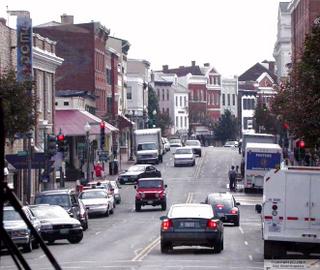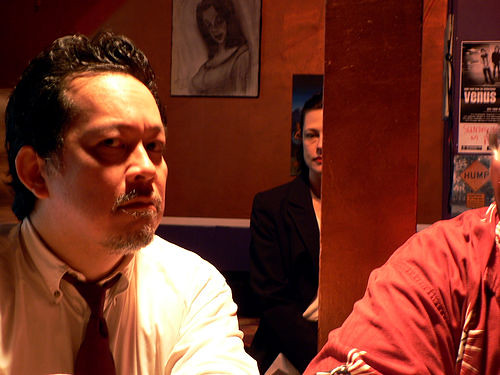 Life is cheap. Georgetown isn’t. It costs about six bucks to get what’s called a chicken pot pie at what passes for a coffee shop in the so-called heart of Georgetown. The pot pie is delicious: eating it you know that you’re putting extra air in the spare tire that hangs around your belly. Still, at six bucks a “pie,” you know it would be a lot cheaper for you just to open up a can of Crisco and shove it down your throat before washing it down with a cup of Maxwell House. But saving money isn’t what brought you to Georgetown. You came to Georgetown to spend it. To choose a new pair of pre-washed Calvin Klein jeans. Choose a Tommy Hilfiger jacket with a pattern that looks like the flag of Lichtenstein. Choose a shiny gold nose ring which from a distance will reflect the sunlight in such a way that it looks like a droplet of snot.
Life is cheap. Georgetown isn’t. It costs about six bucks to get what’s called a chicken pot pie at what passes for a coffee shop in the so-called heart of Georgetown. The pot pie is delicious: eating it you know that you’re putting extra air in the spare tire that hangs around your belly. Still, at six bucks a “pie,” you know it would be a lot cheaper for you just to open up a can of Crisco and shove it down your throat before washing it down with a cup of Maxwell House. But saving money isn’t what brought you to Georgetown. You came to Georgetown to spend it. To choose a new pair of pre-washed Calvin Klein jeans. Choose a Tommy Hilfiger jacket with a pattern that looks like the flag of Lichtenstein. Choose a shiny gold nose ring which from a distance will reflect the sunlight in such a way that it looks like a droplet of snot.That wasn’t always the reason to go to there. Indeed, taking a weekend stroll through Georgetown isn't what it used to be. Where you once found the neighborhood where Washington DC's coolest would congregate, you now have something resembling one of those pretentious suburban shopping malls. Not those dreary strip malls you see in Rockville that were left over from Washington’s Middle Class Diaspora of the sixties, but that new brand of suburban mall: scaled down, red brick buildings you stroll through on your way to Starbuck’s for a decaf cappucino and chocolate chip scone; quaint little shops hawking either expensive clothing or ugly works of art.
Georgetown. It rose out of the swamp in 1751 when some Scotsmen, having forsaken their wee island’s traditions of kilts, bagpipes and haggis for the native American pleasures of smoking, established Georgetown as a tobacco port. With tobacco being a crop that was toiled over by slaves, it wasn’t long before Georgetown also became known for its slave trade, a practice which lasted until the 1862 when it was banned in the District.
Over the years Georgetown grew into a community that was about half black, half white—much like Georgetown University president from 1873 to 1882, the Rev. Patrick F. Healy, who, being the son of a black woman and an Irishman, was half black, half white. And that was pretty much the way Georgetown remained until the FDR’s New Deal brought change. When rich artists and intellectuals, at the behest of Eleanor Roosevelt, flooded the area like vainglorious creatures from the swamp in order to form a more perfect Bohemia.
In the early sixties Georgetown became a popular destination for window shoppers—out of towners who, with their fat, grubby fingers, sullied the wares in shops where Georgetown’s residents actually bought things. But then, as if Georgetown’s suddenly rising popularity with tourists weren’t bad enough, came the cool.
Starting somewhere around 1967, the fabled “summer of love,” Georgetown became the place for hippies to hang out, tossing their long hair on the corner of Wisconsin and M and flaunting the multicolored shirts and love beads which they believed were statements of protest against The Establishment. Young men with glazed eyes and scraggly beards proudly sold acid and pot in front of what would become (and then cease to be) The Key Theater. Young women, deeming undergarments as symbolic shackles of the military industrial complex, wore tie dyed tank tops and hip hugging blue jeans over their bare flesh as they hawked underground newspapers like The Washington Free Press or The Quicksilver Times. It was a time when revolution was in the air, when if you weren't part of the solution you were part of the problem; a time when some people felt the urge to rebel against even the most innocent of conventions, and rather than shake hands upon greeting one another would instead flash the peace sign. Then there were those radicals who, forgoing that quaint pleasantry, would immediately take off their clothes and "get it on" as the saying went.
It all looks pretty silly now, but back then hippie culture with all its myriad trappings was considered cool.
Over the years other things became cool. And just as hippies replaced the beatniks (who in their heyday lugged their bongo drums and facial hair to Dupont Circle), punks replaced the hippies. Coming after the punks were—among other things, and not necessarily in this order—grunge (music to sniff air-freshener to), cigar bars ("Look, Ma, I'm smoking a cigar and drinking a thirty dollar shot of cognac!"), the revival of big band music (for the purpose of a an obnoxiously self-conscious variety of ballroom dancing), and riot grrls (a movement which later metamorphosed into a gigantic book discussion group).
Of course, by the time the media picked up on these later manifestations of Cool they were already dead. Still, one begins to wonder: With hippie, punk, grunge, and riot grrl culture all dead, what's to take their place in the realm of The Cool?
The answer: Nothing. And though on occasion you will find things which people describe, for lack of a more precise term, as "cool," there is nothing left which truly fits that description. Because like Maury Povich shooting blanks into Connie Chung's womb back in the eighties, Cool has failed to reproduce itself. Because after having hung on to a pain ridden existence with the help of life support systems throughout the nineties, Cool has finally kicked the bucket. Because not only has cool been beaten down, it has also been executed.
That's right, Cool, with all its subsidiary attributes of non-conformity, fearlessness and casual sophistication is dead. Although there are those who are desperately faithful to the notion that culture and history are cyclic in nature, Cool is one thing that's not coming back. And although it's still raising a big stink as it wallows in the early stages of cultural decay, that stink will fade to the point where all we'll have left are fetid memories.
But let us not morn the passing of the Cool. Let us, rather, celebrate its demise. It served us well for a time, but that time has passed.

No comments:
Post a Comment